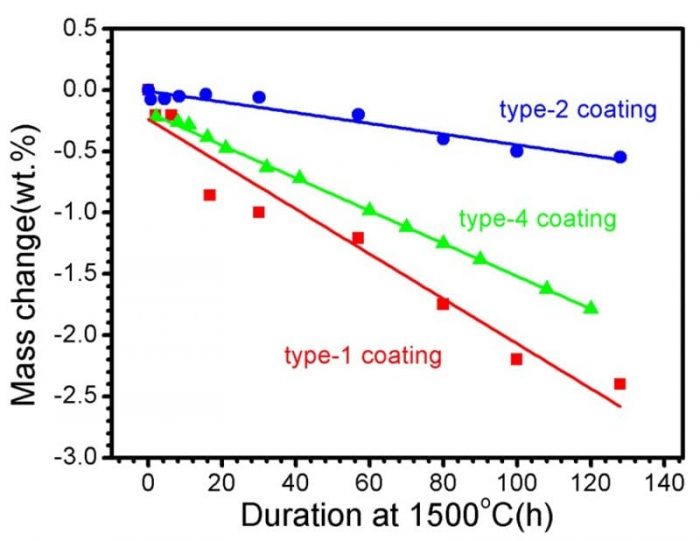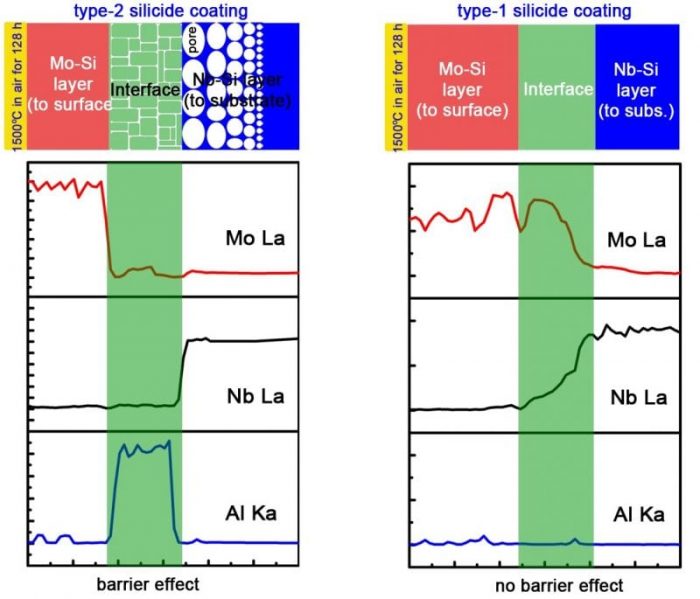
The rapid development of aerospace technology demands engine components, especially turbine blades, to withstand high temperatures and meanwhile maintain high-temperature mechanical properties. Only reaching these goals can make the engine achieve greater thrust ratio and higher work efficiency. Nickel-based superalloys are widely utilized for this purpose.
At present, the operation temperature of nickel-based superalloy has reached 85 % of the melting point and further improvement of the temperature capability is very difficult to achieve because most advanced superalloys melt at 1350 °C. Hence, developing novel alloys are greatly expected to increase the turbine engine inlet temperature as well as improve aircraft engine performance.
Refractory intermetallic Nb-based alloys, in particular, the Nb-Si alloy, are considered to be the most promising candidates due to their high melting point as well as high room-temperature fracture toughness (> 20 MPa·m1/2). The major challenge facing application of Nb-based alloys is the weak oxidation resistance, which restricts alloys only to be applied under a protective atmosphere.
The fact of improving oxidation resistance by incorporating Si element into alloy or establishing silicide coatings on the alloy surface has been successfully attempted. The Si is selected because it can generate protective SiO2 with very low oxygen diffusion. But methods of alloying or mono-coating with structural defects could not avoid the simultaneous formation of oxidation byproduct Nb2O5. Nb2O5 has a larger volumetric ratio than the Nb-based alloy, thus causing tremendous stress at the interface between coating and substrate. As a result, the oxidized surface layer was easily inclined to exfoliate, which therefore accelerated the degradation of the Nb-based alloy.
In addition, the existence of Nb2O5 extremely restricted the operation temperature that was not beyond 1500 oC in the air due to the relatively low melting point of Nb2O5 (1485 oC). Elemental alloying strategy, which could provide higher electronegativity to oxygen than Nb, could be usually implemented to enhance the ability against oxidation without forming Nb-oxides. Unfortunately, the maximum operating temperature still did not exceed 1450 oC yet with limited service duration.
Table 1 Combined silicide coatings through different preparations
| Species | Substrate pre-treatment | Coating composition (from outer to inner) |
| Type 1 | grinding | SAPS-MoSi2/HAPC-NbSi2 |
| Type 2 | grit-blasting | SAPS-MoSi2/Al2O3-adsorbed-particle/HAPC-NbSi2 |
| Type 3 | grinding | SAPS-MoSi2/SAPS-Al2O3/HAPC-NbSi2 |
| Type 4 | grit-blasting | SAPS-MoSi2 |
Combined silicide coatings were proposed based on above background. Different interfacial combined silicide coatings were prepared through halide activated pack cementation (HAPC) and supersonic atmospheric plasma spraying (SAPS) combination in recent work (see Table 1).
To construct an Al2O3 barrier layer, SAPS-Al2O3 layer was designed between two silicide coatings (type-3). But the type-3 coating was found to present a serious interface de-bonding phenomenon, which cannot be applied in the subsequent oxidation test. Therefore, the adsorbed Al2O3 barrier layer was adopted to alleviate the interfacial mismatch stress and promote the thermal stability by taking the advantage of its relatively loose microstructure.

Fig. 1 Oxidation kinetics curves of silicide coated Nb alloy at 1500oC (Republished with permission from Elsevier)
The type-2 coating with adsorbed alumina barrier layer was demonstrated to have the most outstanding protective ability among all silicide coatings (see Fig. 1). And it can be found that the multi-layered coated Nb alloy followed approximately linear kinetics. The mass loss behavior at 1500 oC in air suggested that oxidation mechanism was not controlled by the oxygen diffusion mechanism but by the interfacial element diffusion.
The barrier effect of the adsorbed Al2O3 layer can be revealed by element distribution through coating thickness (see Fig. 2). The type-2 silicide coating possessed obviously jumped element distribution, whereas the type-1 coating suggested a gradient element distribution at the interface. The existed barrier layer can keep the layered stability by the occurrence of the porous Nb5Si3 in size of 1-4µm in the type-2 case.

Fig. 2 Microstructure and element diffusion of multi-layered silicide coatings after oxidation at 1500oC for 128 h (Republished with permission from Elsevier)
These findings are described in the article entitled A long-term ultrahigh temperature application of layered silicide coated Nb alloy in air, recently published in Applied Surface Science. This work was conducted by Dr. Jia Sun from Northwestern Polytechnical University.








